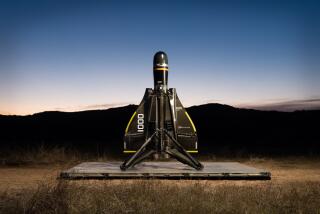Drone is catapulted off aircraft carrier in milestone flight test
- Share via
In a historic feat for the U.S. Navy, a stealthy bat-winged drone was catapulted off an aircraft carrier’s flight deck before it soared above the Atlantic and into the blue sky.
On Tuesday morning, the X-47B experimental drone was launched from the nuclear-powered aircraft carrier George H.W. Bush as it floated off the Virginia coast.
The test flight was seen as a milestone in drone technology and the program, which has been eight years in the making.
“Today we saw a small but significant pixel in the future picture of our Navy as we begin integration of unmanned systems into arguably the most complex war-fighting environment that exists today: the flight deck of a nuclear-powered aircraft carrier,” Vice Adm. David Buss, commander of naval air forces and known as the Navy’s “air boss,” said in a statement.
The radar-evading drone was launched from the deck at 11:18 a.m. Eastern time. It executed several maneuvers designed to simulate tasks that the aircraft would have to perform when it lands on a ship. Then, after about 65 minutes of flight, the Navy said the drone safely flew across Chesapeake Bay to land at Naval Air Station Patuxent River in Maryland.
The X-47B, built by Northrop Grumman Corp., is designed to land on the deck of an aircraft carrier — one of aviation’s most difficult maneuvers — but that was not part of Tuesday’s test.
Carl Johnson, Northrop’s X-47B program manager, compared Tuesday’s launch with “the Navy’s first catapult of a manned aircraft, which occurred in Nov. 1915 from the armored cruiser USS North Carolina. We are delighted to help launch this new era of naval capability.”
The Navy has said it expects the X-47B to land on a carrier this year, relying on pinpoint GPS coordinates and advanced avionics. The carrier’s computers digitally transmit the carrier’s speed, crosswinds and other data to the drone as it approaches from miles away.
The X-47B’s technology could mark a paradigm shift in warfare because the drone is capable of autonomous flight.
Currently, combat drones are controlled remotely by a human pilot. But the X-47B is designed to carry out a combat mission controlled entirely by a computer. A human pilot would design its flight path and send it on its way; a computer program would guide it from a ship to the target and back.
Peter W. Singer, author of “Wired for War,” a book about robotic warfare, said the X-47B’s flight off the carrier gave a glimpse of the promise of drone technology.
It’s “a historic moment for aviation,” Singer said. “Just one after another, they keep knocking down more and more of those things that the naysayers said never could be done” with drones.
What also sets this drone apart from most of today’s combat drones is that it is stealthy and jet-powered.
The X-47B, which resembles a miniature B-2 stealth bomber, has a 62-foot wingspan and can fly higher than 40,000 feet. It has a range of more than 2,400 miles and can reach high subsonic speeds.
The drone is designed to fly farther and stay in the air longer than existing aircraft because it does not depend on a human pilot’s endurance. Navy fighter pilots may fly missions that last as long as 10 hours. Current drones can fly for three times that long.
The X-47B is an experimental jet — that’s what the X stands for — and is designed to demonstrate new technology, such as automated takeoffs, landings and refueling. The drone also has a weapons bay with a payload capacity of 4,500 pounds, but the Navy said it has no plans to arm the aircraft.
The first X-47B had its maiden flight from Edwards Air Force Base in 2011, where it continued testing until last year when it was trucked from the Mojave Desert to Naval Air Station Patuxent River. The drone’s design was so startling that motorists passing it by on the highway thought it was a UFO.
Over the last year, the Navy conducted shore-based catapults at Patuxent River, Md. It also conducted deck-handling and ship-integration testing to demonstrate the capability to safely operate the X-47B on an aircraft carrier flight deck.
There were two X-47Bs developed and built under a contract that has escalated to $1.4 billion. They were constructed behind barbed-wire fences and double security doors at Northrop’s expansive facility in Palmdale.
The Navy currently flies MQ-8B Fire Scout helicopter drones, also built by Northrop, but their range is more limited and the aircraft are far slower. The Navy wants to buy a fleet of fixed-wing drones within the next seven years.
More to Read
Inside the business of entertainment
The Wide Shot brings you news, analysis and insights on everything from streaming wars to production — and what it all means for the future.
You may occasionally receive promotional content from the Los Angeles Times.











